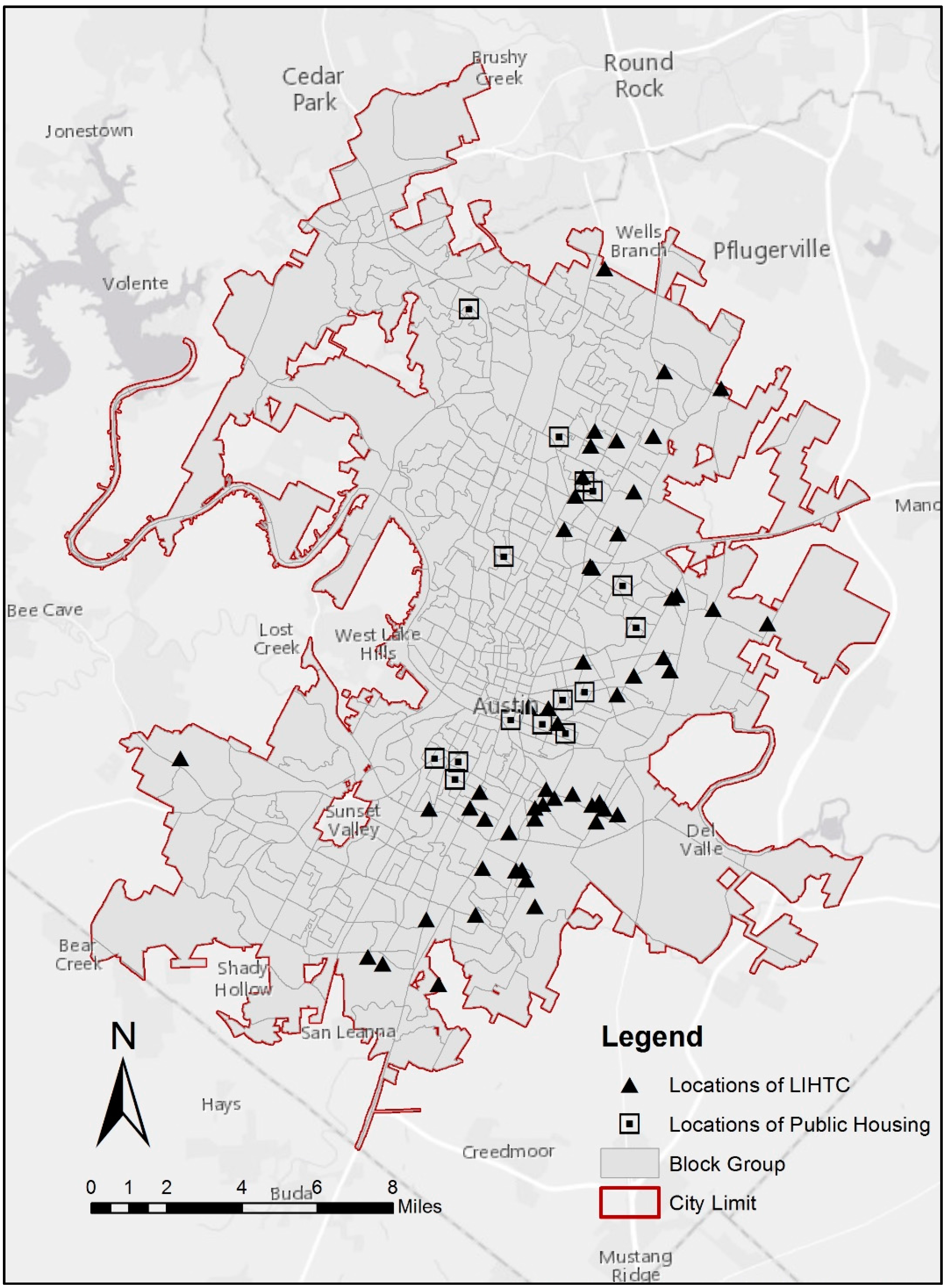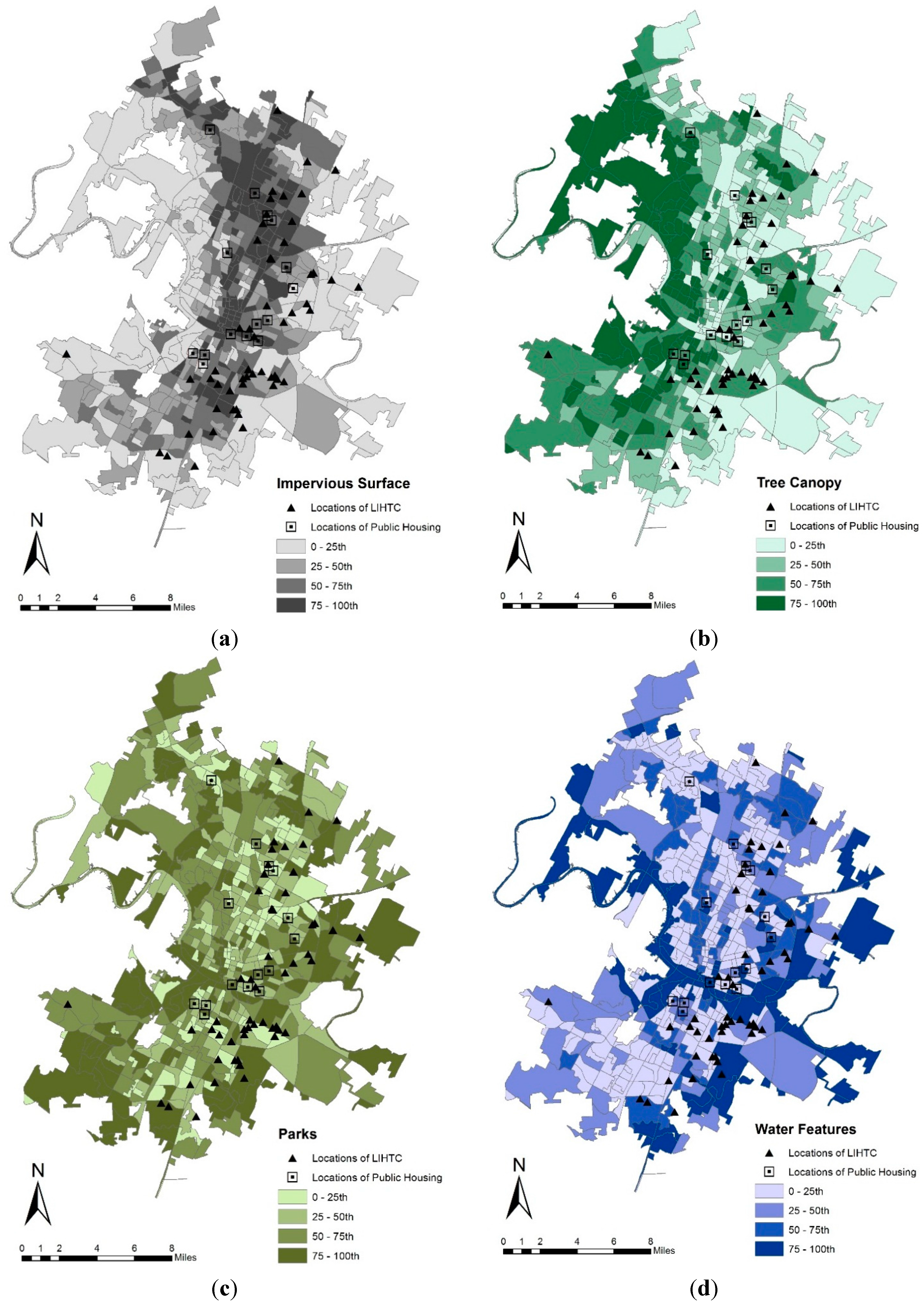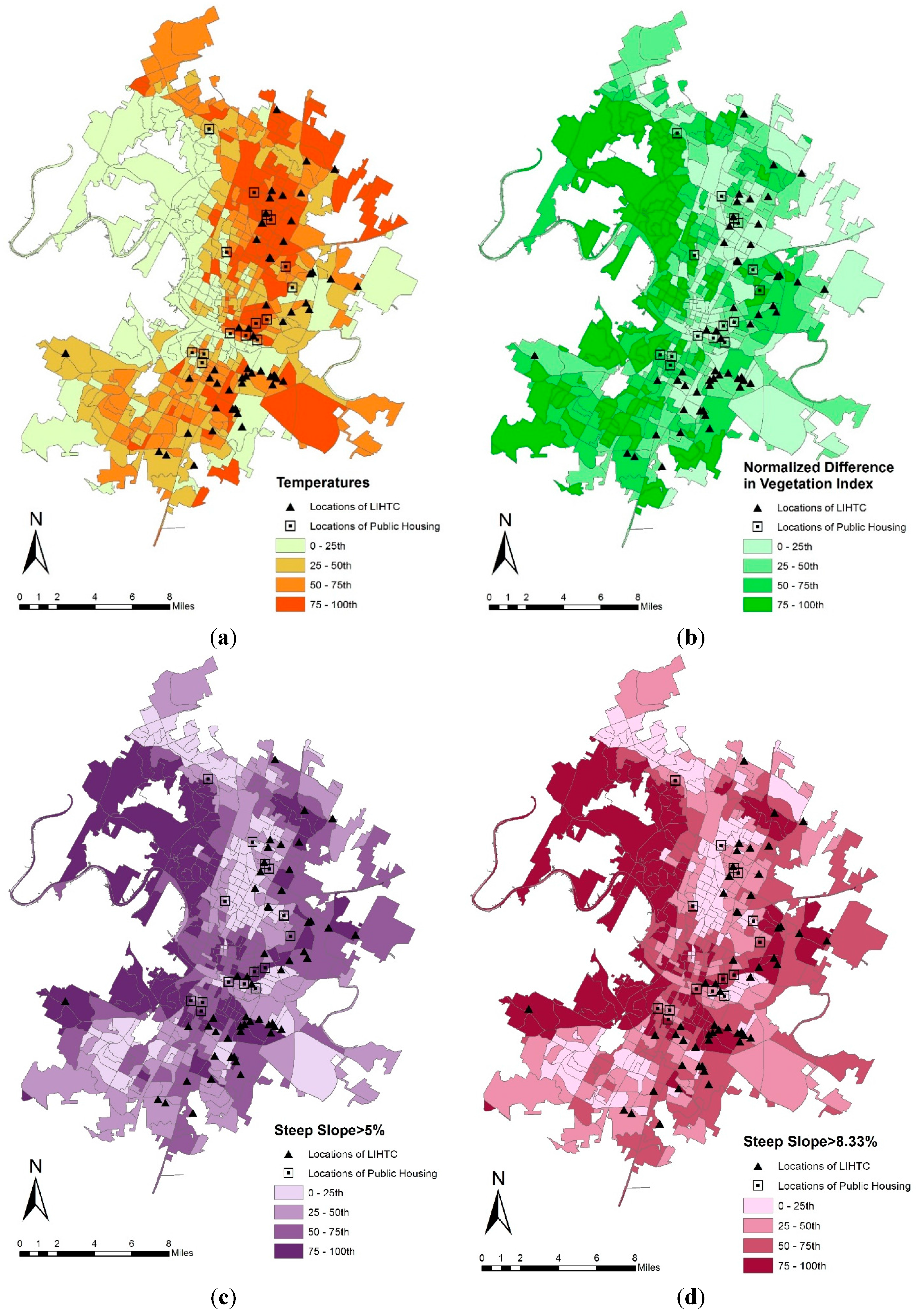Estimating Natural Environmental Characteristics of Subsidized Households: A Case Study of Austin, Texas
Abstract
:1. Introduction
2. Literature Review
2.1. Subsidized Housing Developments and Socioeconomic Environments
2.2. Benefits of Natural Environments
3. Data and Methodology
3.1. Study Area and Data Collection

3.2. Measures for Natural Environmental Characteristics
3.3. Statistical Analyses
4. Results and Discussion
4.1. Comparison T-Tests
4.1.1. Socioeconomic Characteristics
| Variables | Non-LIHTC Neighborhoods | LIHTC Neighborhoods | Difference in Mean | ||||
|---|---|---|---|---|---|---|---|
| N | Mean | S.D. | N | Mean | S.D. | ||
| Household Income ($) | 452 | 52,991 | 27,558 | 42 | 33,797 | 14,683 | 19,194 *** |
| Percentage Minority | 452 | 38.48 | 26.38 | 42 | 70.46 | 22.79 | −31.96 *** |
| Percentage Poverty | 452 | 12.41 | 13.29 | 42 | 21.21 | 12.47 | −8.80 *** |
| Percentage Unemployment | 452 | 4.09 | 3.99 | 42 | 6.51 | 4.15 | −2.42 *** |
| Percentage Female-Headed Family | 438 | 20.63 | 17.25 | 42 | 33.75 | 16.63 | −13.11 *** |
| Percentage Welfare Receipt | 452 | 1.66 | 2.72 | 42 | 3.21 | 3.54 | −1.80 *** |
| Percentage Teenage School Dropout | 425 | 14.22 | 20.83 | 42 | 23.53 | 16.85 | −9.31 *** |
| Variables | Non-Public Housing Neighborhoods | Public Housing Neighborhoods | Difference in Mean | ||||
|---|---|---|---|---|---|---|---|
| N | Mean | S.D. | N | Mean | S.D. | ||
| Household Income ($) | 480 | 52,019 | 27,290 | 14 | 28,707 | 10,355 | 23,312 *** |
| Percentage Minority | 480 | 40.44 | 27.14 | 14 | 67.40 | 29.79 | −26.96 *** |
| Percentage Poverty | 480 | 12.72 | 13.11 | 14 | 28.21 | 16.25 | −15.50 *** |
| Percentage Unemployment | 480 | 4.17 | 3.89 | 14 | 8.87 | 6.57 | −4.70 *** |
| Percentage Female-Headed Family | 480 | 21.05 | 16.82 | 14 | 46.28 | 24.57 | −25.23 *** |
| Percentage Welfare Receipt | 480 | 1.66 | 2.59 | 14 | 6.45 | 5.69 | −4.79 *** |
| Percentage Teenage School Dropout | 480 | 14.72 | 20.08 | 14 | 26.83 | 24.78 | −12.11 *** |
4.1.2. Natural Environmental Characteristics
| Variables | Non-LIHTC Neighborhoods | LIHTC Neighborhoods | Difference in Mean | ||||
|---|---|---|---|---|---|---|---|
| N | Mean | S.D. | N | Mean | S.D. | ||
| Tree Canopy (%) | 452 | 34.31 | 14.98 | 42 | 26.66 | 9.81 | 7.65 ** |
| Impervious Surface (%) | 452 | 30.06 | 16.23 | 42 | 33.47 | 15.82 | −3.42 |
| Parks (%) | 452 | 7.46 | 13.39 | 42 | 8.23 | 12.48 | −0.76 |
| Water Features (%) | 452 | 1.94 | 8.01 | 42 | 0.45 | 0.78 | 1.49 |
| Surface Temperature (°C) | 452 | 32.09 | 2.09 | 42 | 32.91 | 0.94 | −0.81 ** |
| NDVI (ranging from −1 to 1) | 452 | 0.24 | 0.09 | 42 | 0.19 | 0.06 | 0.05 *** |
| Steep Slope (%) > 5% | 452 | 12.58 | 10.75 | 42 | 14.66 | 9.95 | −2.08 |
| Steep Slope (%) > 8.33% | 452 | 6.84 | 8.51 | 42 | 7.04 | 6.38 | −0.20 |
| Variables | Non-Public Housing Neighborhoods | Public Housing Neighborhoods | Difference in Mean | ||||
|---|---|---|---|---|---|---|---|
| N | Mean | S.D. | N | Mean | S.D. | ||
| Tree Canopy (%) | 480 | 33.81 | 14.85 | 14 | 28.58 | 10.38 | 5.23 |
| Impervious Surface (%) | 480 | 30.16 | 16.21 | 14 | 36.83 | 15.28 | −6.67 |
| Parks (%) | 480 | 7.48 | 13.20 | 14 | 9.01 | 16.93 | −1.53 |
| Water Features (%) | 480 | 1.79 | 7.68 | 14 | 2.59 | 7.87 | −0.80 |
| Surface Temperature (°C) | 480 | 32.15 | 2.04 | 14 | 32.66 | 1.42 | −0.51 |
| NDVI (ranging from −1 to 1) | 480 | 0.24 | 0.09 | 14 | 0.20 | 0.08 | 0.04 * |
| Steep Slope (%) > 5% | 480 | 12.81 | 10.75 | 14 | 10.88 | 8.48 | 1.93 |
| Steep Slope (%) > 8.33% | 480 | 6.92 | 8.49 | 14 | 4.62 | 4.79 | 2.32 |


4.2. Binary Logistic Regressions
4.2.1. Natural Environmental Correlates of LIHTC and Public Housing Neighborhoods
| Variables | LIHTC Neighborhoods | Public Housing Neighborhoods | ||
|---|---|---|---|---|
| Odds Ratio | p > |z| | Odds Ratio | p > |z| | |
| Percentage Minority | 1.040 *** | <0.000 | 1.031 *** | 0.033 |
| Income ($1,000) | 0.962 ** | 0.048 | 0.953 | 0.141 |
| Percentage Poverty | 0.976 | 0.188 | 1.021 | 0.383 |
| Median Housing Value ($1,000) | 1.005 | 0.114 | 1.007 | 0.201 |
| NDVI † | 0.902 *** | 0.005 | 1.070 | 0.389 |
| Impervious Surface | 0.971 * | 0.092 | 1.038 | 0.337 |
| Steep Slopes > 8.33% (%) | 1.045 ** | 0.025 | 0.982 | 0.560 |
| Parks | 1.019 | 0.242 | 1.012 | 0.576 |
| Water Features | 0.775 | 0.141 | 1.058 | 0.225 |
| Number of Observations | 494 | 494 | ||
| LR Chi | 71.36 | 23.31 | ||
| Pro > Chi-Sq | <0.0001 | 0.0055 | ||
| Pseudo R2 | 0.2483 | 0.1830 | ||
4.2.2. Socioeconomic Correlates of LIHTC and Public Housing Neighborhoods
5. Conclusions
Acknowledgments
Author Contributions
Conflicts of Interest
References and Notes
- Newman, S.J.; Schnare, A.B. “… And a suitable living environment”: The failure of housing programs to deliver on neighborhood quality. Hous. Policy Debate 1997, 8, 703–741. [Google Scholar] [CrossRef]
- Oakley, D. Locational Patterns of Low-Income Housing Tax Credit Developments A Sociospatial Analysis of Four Metropolitan Areas. Urban Aff. Rev. 2008, 43, 599–628. [Google Scholar] [CrossRef]
- Freeman, L. Siting Affordable Housing: Location and Neighborhood Trends of Low Income Housing Tax Credit Developments in the 1990s; Brookings Institution, Center on Urban and Metropolitan Policy: Washington, DC, USA, 2004. [Google Scholar]
- Van Zandt, S.; Mhatre, P.C. Growing pains: Perpetuating inequality through the production of low-income housing in the Dallas/Fort Worth Metroplex. Urban Geogr. 2009, 30, 490–513. [Google Scholar] [CrossRef]
- Rogers, S.H.; Halstead, J.M.; Gardner, K.H.; Carlson, C.H. Examining walkability and social capital as indicators of quality of life at the municipal and neighborhood scales. Appl. Res. Qual. Life 2011, 6, 201–213. [Google Scholar]
- Squires, G.D.; Kubrin, C.E. Privileged places: Race, uneven development and the geography of opportunity in urban America. Urban Stud. 2005, 42, 47–68. [Google Scholar] [CrossRef]
- Kasarda, J.D. Inner-city concentrated poverty and neighborhood distress: 1970 to 1990. Hous. Policy Debate 1993, 4, 253–302. [Google Scholar] [CrossRef]
- Pendall, R. Why voucher and certificate users live in distressed neighborhoods. Hous. Policy Debate 2000, 11, 881–910. [Google Scholar] [CrossRef]
- Chiesura, A. The role of urban parks for the sustainable city. Landsc. Urban Plan. 2004, 68, 129–138. [Google Scholar]
- Nowak, D.J.; Dwyer, J.F. Understanding the benefits and costs of urban forest ecosystems. In Urban and Community Forestry in the Northeast; Springer: Berlin, Germany; Heidelberg, Germany, 2007; pp. 25–46. [Google Scholar]
- Troped, P.J.; Saunders, R.P.; Pate, R.R.; Reininger, B.; Ureda, J.R.; Thompson, S.J. Associations between self-reported and objective physical environmental factors and use of a community rail-trail. Prevent. Med. 2001, 32, 191–200. [Google Scholar] [CrossRef] [PubMed]
- Bedimo-Rung, A.L.; Mowen, A.J.; Cohen, D.A. The significance of parks to physical activity and public health: A conceptual model. Am. J. Prevent. Med. 2005, 28, 159–168. [Google Scholar] [CrossRef] [PubMed]
- Crompton, J.L. Financing and Acquiring Park and Recreation Resources; Human Kinetics: Champaign, IL, USA, 1999. [Google Scholar]
- Parks, S.; Housemann, R.; Brownson, R.C. Differential correlates of physical activity in urban and rural adults of various socioeconomic backgrounds in the United States. J. Epidemiol. Community Health 2003, 57, 29–35. [Google Scholar] [CrossRef] [PubMed]
- Mitchell, R.; Popham, F. Effect of exposure to natural environment on health inequalities: An observational population study. Lancet 2008, 372, 1655–1660. [Google Scholar] [CrossRef]
- Harlan, S.L.; Brazel, A.J.; Prashad, L.; Stefanov, W.L.; Larsen, L. Neighborhood microclimates and vulnerability to heat stress. Soc. Sci. Med. 2006, 63, 2847–2863. [Google Scholar] [CrossRef] [PubMed]
- De Vries, S.; Verheij, R.A.; Groenewegen, P.P.; Spreeuwenberg, P. Natural environments-healthy environments? An exploratory analysis of the relationship between greenspace and health. Environ. Plan. A 2003, 35, 1717–1732. [Google Scholar] [CrossRef]
- Maas, J.; Verheij, R.A.; Groenewegen, P.P.; de Vries, S.; Spreeuwenberg, P. Green space, urbanity, and health: How strong is the relation? J. Epidemiol. Community Health 2006, 60, 587–592. [Google Scholar] [CrossRef] [PubMed]
- Grahn, P.; Stigsdotter, U.A. Landscape planning and stress. Urban For. Urban Green. 2003, 2, 1–18. [Google Scholar] [CrossRef]
- Eriksen, M.D.; Rosenthal, S.S. Crowd out effects of place-based subsidized rental housing: New evidence from the LIHTC program. J. Public Econ. 2010, 94, 953–966. [Google Scholar] [CrossRef]
- Schwartz, A.F. Housing Policy in the United States; Routledge: London, UK, 2014. [Google Scholar]
- Woo, A.; Joh, K.; van Zandt, S. Impacts of the Low-Income Housing Tax Credit Program on Neighborhood Housing Turnover. Urban Aff. Rev. 2014. [Google Scholar] [CrossRef]
- Rohe, W.M.; Freeman, L. Assisted housing and residential segregation: The role of race and ethnicity in the siting of assisted housing developments. J. Am. Plan. Assoc. 2001, 67, 279–292. [Google Scholar] [CrossRef]
- McClure, K. The low-income housing tax credit as an aid to housing finance: How well has it worked? Hous. Policy Debate 2000, 11, 91–114. [Google Scholar] [CrossRef]
- Ainsworth, B.E.; Keenan, N.L.; Strogatz, D.S.; Garrett, J.M.; James, S.A. Physical activity and hypertension in black adults: The Pitt County Study. Am. J. Public Health 1991, 81, 1477–1479. [Google Scholar] [PubMed]
- Mason, J.O.; McGinnis, J.M. “Healthy People 2000”: An overview of the national health promotion and disease prevention objectives. Public Health Rep. 1990, 105, 441–446. [Google Scholar] [CrossRef] [PubMed]
- Taylor, W.C.; Baranowski, T.; Young, D.R. Physical activity interventions in low-income, ethnic minority, and populations with disability. Am. J. Prevent. Med. 1998, 15, 334–343. [Google Scholar]
- Saelens, B.E.; Sallis, J.F.; Black, J.B.; Chen, D. Neighborhood-based differences in physical activity: An environment scale evaluation. Am. J. Public Health 2003, 93, 1552–1558. [Google Scholar] [CrossRef] [PubMed]
- Giles-Corti, B.; Broomhall, M.H.; Knuiman, M.; Collins, C.; Douglas, K.; Ng, K.; Lange, A.; Donovan, R.J. Increasing walking: How important is distance to, attractiveness, and size of public open space? Am. J. Prevent. Med. 2005, 28, 169–176. [Google Scholar] [CrossRef] [PubMed]
- Rodriguez, D.A.; Brown, A.L.; Troped, P.J. Portable global positioning units to complement accelerometry-based physical activity monitors. Med. Sci. Sports Exerc. 2005, 37, S572–S581. [Google Scholar] [CrossRef] [PubMed]
- Berrigan, D.; Pickle, L.W.; Dill, J. Associations between street connectivity and active transportation. Int. J. Health Geogr. 2010. [Google Scholar] [CrossRef] [PubMed]
- Humpel, N.; Owen, N.; Leslie, E. Environmental factors associated with adults’ participation in physical activity: A review. Am. J. Prevent. Med. 2002, 22, 188–199. [Google Scholar] [CrossRef]
- Kaczynski, A.T.; Henderson, K.A. Environmental correlates of physical activity: A review of evidence about parks and recreation. Leis. Sci. 2007, 29, 315–354. [Google Scholar] [CrossRef]
- Almanza, E.; Jerrett, M.; Dunton, G.; Seto, E.; Pentz, M.A. A study of community design, greenness, and physical activity in children using satellite, GPS and accelerometer data. Health Place 2012, 18, 46–54. [Google Scholar] [CrossRef] [PubMed]
- Fjørtoft, I. Landscape as playscape: The effects of natural environments on children’s play and motor development. Child. Youth Environ. 2004, 14, 21–44. [Google Scholar]
- Bell, J.F.; Wilson, J.S.; Liu, G.C. Neighborhood greenness and 2-year changes in body mass index of children and youth. Am. J. Prevent. Med. 2008, 35, 547–553. [Google Scholar] [CrossRef] [PubMed]
- Liu, G.C.; Wilson, J.S.; Qi, R.; Ying, J. Green neighborhoods, food retail and childhood overweight: Differences by population density. Am. J. Health Promot. 2007, 21, 317–325. [Google Scholar] [CrossRef] [PubMed]
- Wolch, J.; Jerrett, M.; Reynolds, K.; McConnell, R.; Chang, R.; Dahmann, N.; Brady, K.; Gilliland, F.; Su, J.G.; Berhane, K. Childhood obesity and proximity to urban parks and recreational resources: A longitudinal cohort study. Health Place 2011, 17, 207–214. [Google Scholar] [CrossRef] [PubMed]
- Kaplan, R.; Kaplan, S. The Experience of Nature: A Psychological Perspective; CUP Archive: Cambridge, UK, 1989. [Google Scholar]
- Hartig, T.; Evans, G.W. Psychological foundations of nature experience. Adv. Psychol. 1993, 96, 427–427. [Google Scholar]
- Staats, H.; Kieviet, A.; Hartig, T. Where to recover from attentional fatigue: An expectancy-value analysis of environmental preference. J. Environ. Psychol. 2003, 23, 147–157. [Google Scholar] [CrossRef]
- Ulrich, R. View through a window may influence recovery. Science 1984, 224, 224–225. [Google Scholar]
- Ulrich, R.S.; Simons, R.F.; Losito, B.D.; Fiorito, E.; Miles, M.A.; Zelson, M. Stress recovery during exposure to natural and urban environments. J. Environ. Psychol. 1991, 11, 201–230. [Google Scholar] [CrossRef]
- Kweon, B.S.; Sullivan, W.C.; Wiley, A.R. Green common spaces and the social integration of inner-city older adults. Environ. Behav. 1998, 30, 832–858. [Google Scholar] [CrossRef]
- Peters, K.; Elands, B.; Buijs, A. Social interactions in urban parks: Stimulating social cohesion? Urban For. Urban Green. 2010, 9, 93–100. [Google Scholar] [CrossRef]
- Kaźmierczak, A. The contribution of local parks to neighbourhood social ties. Landsc. Urban Plan. 2013, 109, 31–44. [Google Scholar] [CrossRef]
- Coley, R.L.; Sullivan, W.C.; Kuo, F.E. Where does community grow? The social context created by nature in urban public housing. Environ. Behav. 1997, 29, 468–494. [Google Scholar] [CrossRef]
- Kuo, F.E.; Sullivan, W.C. Aggression and violence in the inner city effects of environment via mental fatigue. Environ. Behav. 2001, 33, 543–571. [Google Scholar] [CrossRef]
- Kuo, F.E.; Sullivan, W.C. Environment and crime in the inner city does vegetation reduce crime? Environ. Behav. 2001, 33, 343–367. [Google Scholar] [CrossRef]
- Forbes. Available online: http://www.forbes.com/pictures/emeg45iikm/1-austin-texas/ (accessed on 13 March 2015).
- U.S. Census Bureau. Available online: http://quickfacts.census.gov/qfd/states/48/4805000.html (accessed on 3 June 2015).
- BBC Research and Consulting. Comprehensive Housing Market Study: City of Austin; BBC Research and Consulting: Denver, CO, USA, 2009. [Google Scholar]
- Givoni, B.; Noguchi, M.; Saaroni, H.; Pochter, O.; Yaacov, Y.; Feller, N.; Becker, S. Outdoor comfort research issues. Energy Build. 2003, 35, 77–86. [Google Scholar] [CrossRef]
- Kalkstein, L.; Smoyer, K. The impact of climate change on human health: Some international implications. Experientia 1993, 49, 969–979. [Google Scholar] [CrossRef] [PubMed]
- Laschewski, G.; Jendritzky, G. Effects of the thermal environment on human health: An investigation of 30 years of daily mortality data from SW Germany. Clim. Res. 2002, 21, 91–103. [Google Scholar]
- Kauffman, G.J.; Brant, T. The role of impervious cover as a watershed-based zoning tool to protect water quality in the Christina river basin of Delaware, Pennsylvania, and Maryland. Proc. Water Environ. Fed. 2000, 2000, 1656–1667. [Google Scholar] [CrossRef]
- Timperio, A.; Ball, K.; Salmon, J.; Roberts, R.; Giles-Corti, B.; Simmons, D.; Baur, L.A.; Crawford, D. Personal, family, social, and environmental correlates of active commuting to school. Am. J. Prevent. Med. 2006, 30, 45–51. [Google Scholar] [CrossRef] [PubMed]
- Jensen, J.R. Introductory Digital Image Processing: A Remote Sensing Perspective, (3rd ed.); Prentice-Hall Inc: Upper Saddle River, NJ, USA, 2005. [Google Scholar]
- The digital numbers from the Landsat 5TM image data were converted to temperature data using the following three steps: (a) converting the digital numbers to radiance values; (b) converting the radiance to temperature as degrees Kelvin; and (c) converting the degrees Kelvin to degrees Celsius.
- Americans with Disabilities Act ADA checklist for readily achievable barrier removal. Available online: http://www.adachecklist.org/howto.html (accessed on 17 April 2015).
- Wooldridge, J. Introductory Econometrics: A Modern Approach; Cengage Learning: Boston, MA, USA, 2012. [Google Scholar]
- Sugiyama, T.; Leslie, E.; Giles-Corti, B.; Owen, N. Associations of neighbourhood greenness with physical and mental health: Do walking, social coherence and local social interaction explain the relationships? J. Epidemiol. Community Health 2008, 62. [Google Scholar] [CrossRef]
- Rodrı́guez, D.A.; Joo, J. The relationship between non-motorized mode choice and the local physical environment. Transp. Res. Part D 2004, 9, 151–173. [Google Scholar]
© 2015 by the authors; licensee MDPI, Basel, Switzerland. This article is an open access article distributed under the terms and conditions of the Creative Commons Attribution license (http://creativecommons.org/licenses/by/4.0/).
Share and Cite
Kim, Y.-J.; Woo, A. Estimating Natural Environmental Characteristics of Subsidized Households: A Case Study of Austin, Texas. Sustainability 2015, 7, 13433-13453. https://doi.org/10.3390/su71013433
Kim Y-J, Woo A. Estimating Natural Environmental Characteristics of Subsidized Households: A Case Study of Austin, Texas. Sustainability. 2015; 7(10):13433-13453. https://doi.org/10.3390/su71013433
Chicago/Turabian StyleKim, Young-Jae, and Ayoung Woo. 2015. "Estimating Natural Environmental Characteristics of Subsidized Households: A Case Study of Austin, Texas" Sustainability 7, no. 10: 13433-13453. https://doi.org/10.3390/su71013433
APA StyleKim, Y.-J., & Woo, A. (2015). Estimating Natural Environmental Characteristics of Subsidized Households: A Case Study of Austin, Texas. Sustainability, 7(10), 13433-13453. https://doi.org/10.3390/su71013433





